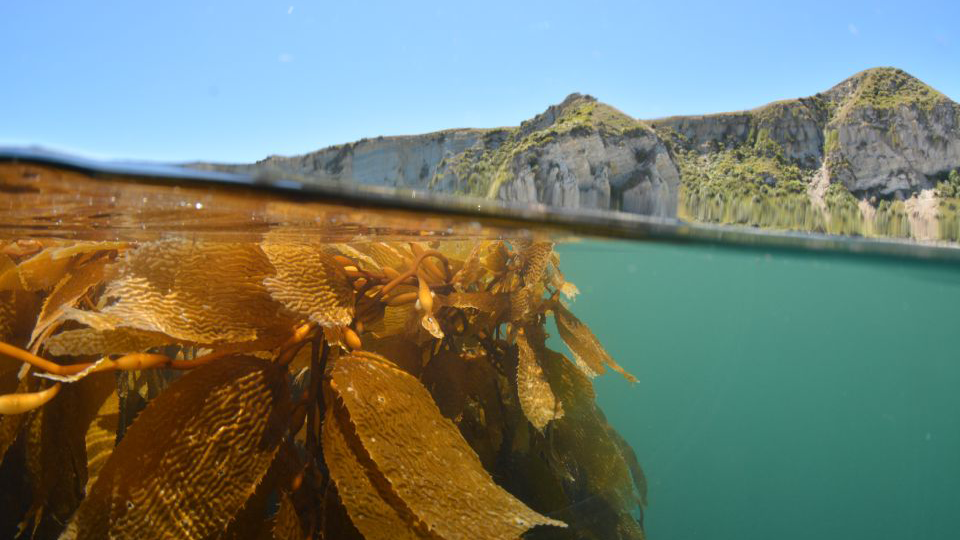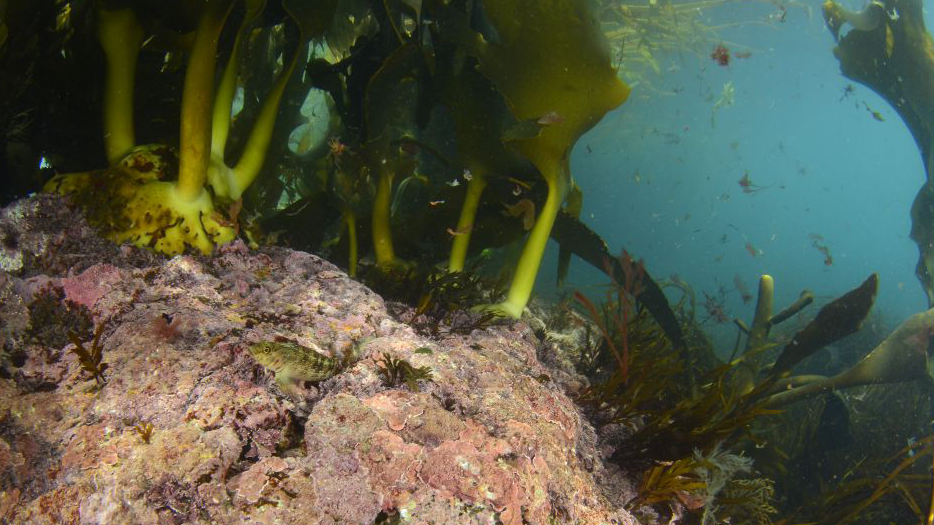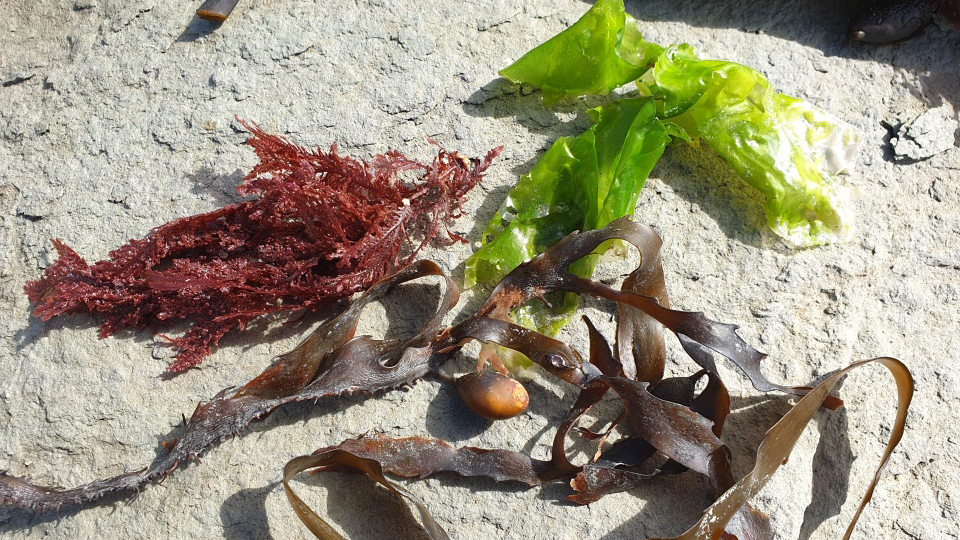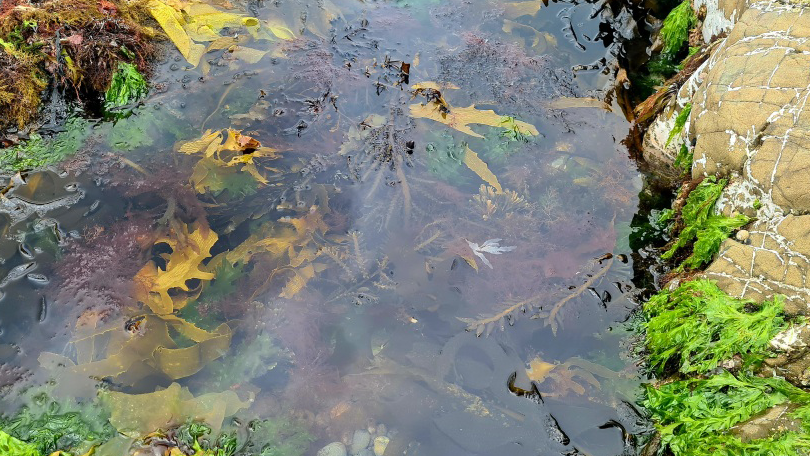Rimurimu is the Māori name covering all types of seaweed. Both rimurimu and seaweed will be used throughout these pages.
Seaweed is a type of algae found in the ocean and is an important food source for millions of marine animals. Seaweed beds and underwater forests provide shelter for many fish and shellfish, making them essential habitats in the ocean.

Seaweed is a type of algae and plays a crucial role in the ocean. Source: Leigh Tait.
Seaweeds are some of the fastest-growing plants on Earth. For example, New Zealand bladder kelp or giant kelp, Macrocystis pyrifera, can grow up to 60cm per day and reach lengths of 45 metres! Some rimurimu live for only a single season, while others, like large kelps, grow all year and live for many years. Aotearoa New Zealand has over 850 native seaweed species, and about a third of them are endemic to New Zealand.
Seaweed structure
Seaweeds have a simple structure. Most have a holdfast, which keeps them anchored to surfaces like rocks, and blades (sometimes divided into fronds) that make up the main body. Large seaweeds also have a stalk, called a stipe, that connects the holdfast to the blade. Air bladders, found on brown seaweeds, help them float to the surface and reach sunlight for photosynthesis.
Like land plants, seaweeds use sunlight for food through photosynthesis. But instead of roots, seaweeds absorb nutrients directly from seawater through the surface of their blades.

Seaweeds have a simple structure. Some have a holdfast to attach to solid surfaces. Source: Leigh Tait.
Types of rimurimu
Seaweeds are grouped by colour: green, brown, and red.
- Green seaweed: Grows in shallow water where sunlight is strong. Aotearoa has about 140 species, including edible sea lettuce.
- Brown seaweed: These range from medium to giant-sized, with kelps being the largest. Neptune’s necklace is a common brown seaweed with water-filled beads that help it retain moisture.
- Red seaweed: Grows in deeper water (up to 25 metres deep). There are around 550 species in Aotearoa, making them the largest group. Karengo, an edible red rimurimu, grows on rocks at the high-tide level.
All rimurimu contain chlorophyll, which helps them make food, but brown and red seaweeds also have extra pigments to help them photosynthesize in deeper waters with less sunlight. These pigments give them a range of colours, from yellow-brown to dark olive, pink to purple, and nearly black.

Seaweeds are grouped by colour: green, brown, and red. Source: LEARNZ.
Role in the marine ecosystem
Seaweeds are crucial to marine ecosystems. Since they make food from sunlight, they support many animals that eat seaweed and are then eaten by larger animals. Rimurimu beds and forests also provide important nurseries for young fish and other sea creatures like kōura (rock lobster), pāua, and kūtai/kuku (mussels). Rimurimu habitats are essential for marine life, offering food, shelter, and a place to grow.

Seaweed habitats are essential for marine life. Source: LEARNZ.
Love Rimurimu
On this virtual field trip, we will be finding out about the Love Rimurimu restoration project. This kaupapa has been working at regenerating Wellington’s seaweed forests since 2021. By restoring sites in the harbour with rimurimu, the team hopes to set up the right environment for regeneration. This will help nature to be a self-sustaining and healthy ecosystem again, making it more resilient into the future (Love Rimurimu restoration project).
Love Rimurimu has a knowledgeable team and lots of supporters. We will be meeting some of the team on the field trip who will be our expert guides. They will be showing us how rimurimu regeneration sites are selected, the process of collecting rimurimu and growing it in a lab, how mātauranga Māori is woven into the kaupapa, and how the team uses scientific processes to monitor each regeneration site – plus lots more!

On the field trip we will learn how the Love Rimurimu team grow giant kelp in a lab, then fix it to rocks, before placing in a regeneration site. Source: LEARNZ.
We will also be meeting two ‘kura kelpers’, ākonga from a local kura who are an important part of Love Rimurimu. You will get to learn some mātauranga about rimurimu from them and see some of the cool activities they get up to as part of the project, like snorkeling to collect giant kelp spores and assisting in plant outs – when kelp grown in the lab is put into the regeneration sites.
It is a great story, so prepare to be inspired to get involved in an environmental restoration project near you!

Ngawaierua and Rakaipo, two kura kelpers from Te Kura Kaupapa Māori o Ngā Mokopuna. Source: LEARNZ.
Māori kupu | key words
rimurimu parāone | brown seaweed
rimurimu kākāriki | green seaweed
rimurimu whero | red seaweed
kanokāriki | chlorophyll
whakahou | restore



